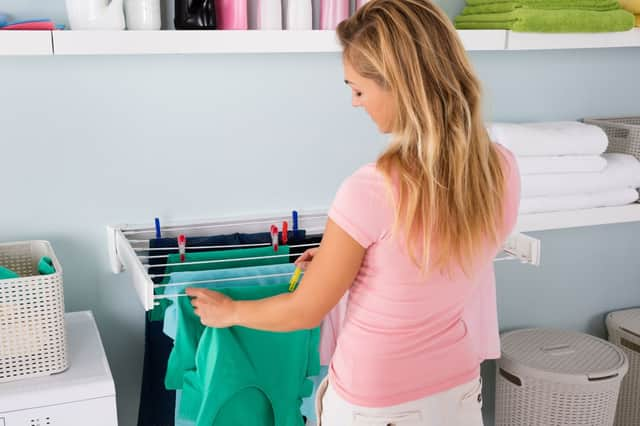Cleaning Hack: Expert tips on how to quickly (and safely)to dry your clothes indoors without a tumble dryer


The weather has been pretty bad of late with cold wet windy days. There is no chance we can hang any washing on the line without the worry of our delicates getting blown into the next door's garden. Ideally the quickest way of drying clothes would be to throw everything in the tumble dryer. Sadly not everyone has that luxury and with the costs of electricity at its highest even if you did have a tumble dryer at home, you may be a bit more reluctant to use it as much these days.
With a bit of creativity and some simple techniques, you can efficiently and safely dry your clothes indoors during the stormy winter months. Appliance expert Matt Ayres from RDO Kitchens & Appliances has given us his best advice and simple tips to help dry clothes indoors.
Run an extra drain cycle
Advertisement
Hide AdAdvertisement
Hide AdIf you don’t have a tumble dryer at home, it’s still possible to use your washing machine to cut down on drying time. Most modern washing machines come with additional spin or drain options which can be run after the wash cycle to remove any additional moisture from your clothing.
While this option does require extra energy use – the costs of this would be minimal. Depending on the energy rating of the washing machine and the length of the cycle – this could cost between 12p and 20p per cycle.
Use towels to absorb moisture
Before hanging your clothes up on an airer – use a dry, clean towel to squeeze out additional moisture from your clothes. Simply lay the towel flat and place the wet items of clothing on top of it. Then roll up the towel and ring it out to remove excess water. This extra step can help significantly cut down the drying time of sopping wet clothing.
If there is a lot of condensation build-up in your home, place absorbent towels near the drying area to catch any excess moisture released during the drying process. This helps in preventing the accumulation of moisture on floors or surfaces and reduces the risk of mould growth.
Invest in a dehumidifier
Advertisement
Hide AdAdvertisement
Hide AdA dehumidifier is extremely useful if you need to do multiple loads of laundry each week and find that your home always has a clotheshorse up drying clothes. Using a dehumidifier in the room where you are drying your clothes can help speed up the drying process.
Hang clothes strategically
The way that clothes are hung up can impact how long it takes for them to dry. While it may be tempting to pile on as many clothes as possible to get them all dry – this can be counter-productive.
Overcrowding can lead to prolonged drying times as there isn’t enough air circulation. To maximise air circulation around the clothing, leave enough space between them on the drying rack or clothesline. This allows the air to flow freely and ensures that each item dries evenly.
Hang shirts and trousers on coat hangers to help free up additional space on the drying rack. Not only does this ensure that clothes aren’t overcrowded, but it’ll also save you the hassle of ironing these items.
Maximise natural heat sources
Advertisement
Hide AdAdvertisement
Hide AdTake advantage of natural heat sources in your home by placing your drying rack or clothesline near windows where sunlight can penetrate. Position the drying area in a room that receives maximum sunlight during the day. It’s also best to crack open the window to allow moist air to escape, especially if you are drying clothes in a confined space.
Rotate your clothes
If you're drying a large batch of clothes, periodically rotate the items on the drying rack to ensure uniform drying. This allows each piece of clothing to receive adequate exposure to heat and air, preventing some items from staying damp while others dry.
Avoid the radiators
Drying clothes on radiators seems like an obvious choice as they are excellent heat sources but it’s best to avoid this trick for drying your clothes. Leaving clothes to dry on the radiator can damage your clothes, especially if the heat is too high.
This heat could cause clothes to shrink, especially if they are made of natural fibres like wool or linen. Drying clothes on the radiators can also create more condensation, which can lead to mould growth in your home.
Comment Guidelines
National World encourages reader discussion on our stories. User feedback, insights and back-and-forth exchanges add a rich layer of context to reporting. Please review our Community Guidelines before commenting.
